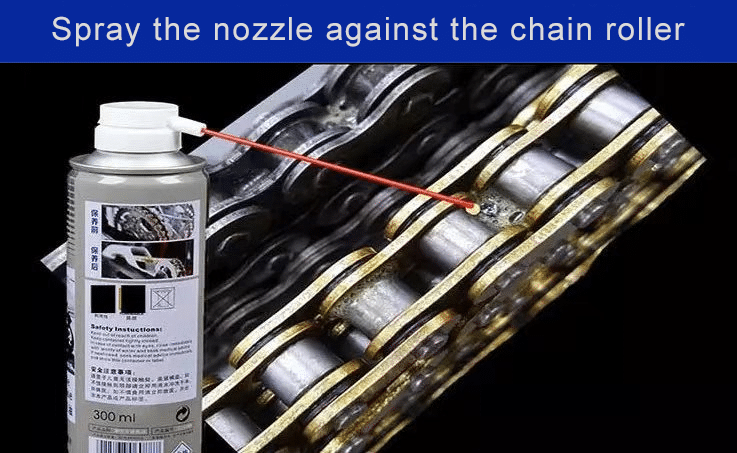Motorcycles have three modes: chain drive, shaft drive and belt drive. Each of these drive modes has its own advantages and disadvantages, among which chain drive is the most common. Here are some common tips on how to care for your motorcycle chain:
If there is stubborn dirt, use a brush to scrub away the dirt. Steel brushes will damage the chain, so please do not use them. Even if you use a soft brush, it may damage the oil seal, so please use it with caution. After scrubbing the chain with a brush, wipe the chain clean with a towel.

Use appropriate chain lubricant and apply it on the chain to ensure that the chain surface is evenly coated.
Lubrication tools: chain oil, towel, sewage basin.
Lubrication method: When lubricating the oil seal chain, please use chain oil containing lubricating ingredients and oil seal protective ingredients. In order to allow the chain oil to penetrate into the gaps of each link, please slowly turn the wheel at a distance of 3 to 10cm at a time and spray the chain evenly with chain oil. To prevent other parts from getting on it, cover it with a towel. If there is too much spray, please place the sewage basin below to collect and dispose of it. After spraying chain oil evenly on the chain, use a towel to wipe off excess oil.
Oil filling position:
a. Between the inner and outer links.
b. Between the inner chain plate and the roller.

Check the chain’s condition and appropriate tightness after 1,000 to 2,000 kilometers (depending on the vehicle type). If it exceeds the limit, the tension must be adjusted.
The appropriate value for general vehicles is about 25~35mm. But whether it is a general road vehicle or an off-road vehicle, the suitable tightness for each vehicle type is different. Be sure to refer to the vehicle’s instruction manual to adjust to the most appropriate tightness.
Note: It should not be too loose or too tight. If the chain is too loose, the chain may fall off the chainring, causing the rear wheel to get stuck. If the chain is too tight, it will also affect the normal operation of the vehicle. At this time, it will bear excessive tension and cause the chain to break.

When the oil-sealed chain is in good condition, it will be used for about 20,000 kilometers. It is recommended to replace the non-oil-sealed chain after about 5,000 kilometers. When replacing the chain, be sure to confirm the style of the chain and whether there is an oil seal (the above distance is when the chain is in good condition and will vary depending on the vehicle type, style, condition and maintenance status)
[Key Point] What happens when the chain is stretched?
Commonly known as “chain elongation”, it is actually not that the inner and outer chain pieces are slowly stretched, but the continuous friction between the plug pin and the roller, causing a gap between the shaft bushing and the internal plug pin. Since the gap becomes longer, the “chain becomes longer”
What does chain lengthening mean?
Even if one chain mesh has only 0.1mm of wear, when there are 100 chain meshes: 0.1mm x 100 = 1cm, it will be stretched by 1cm.
If the chain is stretched:
a. Controlling and riding experience will be reduced
b. Fuel consumption will increase
c. Chain noise will become louder
http://How often should I tighten motorcycle chain?
Wear is not easily noticeable, so check the condition of your chain regularly. For a chain that exceeds its service limit, adjusting the length of the chain cannot improve the condition. In the most serious case, the chain may drop or be damaged, leading to a major accident.
Join our mailing list to be the first one to know more new parts release and marketing info. Stay informed!


We will contact you within 1 working day, please pay attention to the email “wholesale@mpm-motorsports.com”
Comments